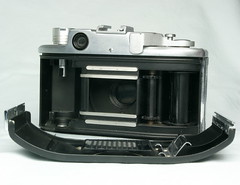No edit summary |
(→Links) |
||
| (13 intermediate revisions by 3 users not shown) | |||
| Line 1: | Line 1: | ||
{{Flickr_image |
{{Flickr_image |
||
| − | |image_source= |
+ | |image_source=http://www.flickr.com/photos/32989794@N08/5422137321/ |
| − | |image= |
+ | |image=http://farm6.static.flickr.com/5016/5422137321_8bc44d24ee_m.jpg |
| − | |image_align= |
+ | |image_align=left |
| + | |image_text=Minolta 'A' 1st version with early rewind knob,<br/>'Chiyoda Kogaku' on bezel. |
||
| − | |image_text= ''Picture by Voxphoto. {{creative commons}}'' |
||
| − | + | }} |
|
{{Flickr_image |
{{Flickr_image |
||
| − | |image_source= |
+ | |image_source=http://www.flickr.com/photos/32989794@N08/5422137331/ |
| − | |image= |
+ | |image=http://farm6.static.flickr.com/5018/5422137331_dafd63beed_m.jpg |
| − | |image_align= |
+ | |image_align=left |
| − | |image_text= '' |
+ | |image_text=Minolta 'A' top shutter speed dial |
}} |
}} |
||
| − | The '''Minolta A''' was launched by [[Chiyoda Kogaku]] in 1955. It was the first of a new series of rangefinder cameras with a four element [[Rokkor]] 1:3.5/45mm lens, an optical viewfinder with superimposed coupled rangefinder, and a rapid wind advance lever. Earliest version had a two-blade Konan Flicker shutter, B, 1/2-1/200s; later versions had [[Citizen Optiper]] MX shutters, B, 1-1/300s, all were M and X flash-synchronized. It was an entry level camera for advanced 35mm photography that was ahead of more expensive popular American rangefinder camera models. The Minolta "A" series was developed through the A-2, A-3, A-5, and then into the AL series that were marketed alongside the Hi-Matics. Maybe one of the early cameras that marked the beginning of the victory of Japanese products on the international market. |
||
{{Flickr_image |
{{Flickr_image |
||
| − | |image_source=http://www.flickr.com/photos/32989794@N08/ |
+ | |image_source=http://www.flickr.com/photos/32989794@N08/5422137327/ |
| − | |image=http:// |
+ | |image=http://farm6.static.flickr.com/5139/5422137327_f70d8722c8_m.jpg |
| − | |image_align= |
+ | |image_align=left |
| − | |image_text= |
+ | |image_text=Minolta 'A' lift-off back. |
}} |
}} |
||
{{br}} |
{{br}} |
||
| + | {{br}} |
||
| + | The '''Minolta A''' was launched by [[Chiyoda Kōgaku Seikō]] in April 1955<ref>JCII/Lewis, ed. "The History of Japanese Cameras" p194.</ref> as the first of their new series of rangefinder cameras. It featured an optical viewfinder with superimposed coupled rangefinder, a shutter speed thumb wheel on top of the camera and a rapid wind advance lever. Earliest version had two-blade [[Konan]] Flicker shutters with speeds B, 1/2sec to 1/200sec. The second version had [[Optiper]] -MX shutters with B, 1-1/300s and the version released in 1956 had [[Citizen]] -MX shutters with B, 1sec to 1/300sec<ref>Sugiyama/Naoi "The Collectors Guide to Japanese Cameras", code numbers 3431, 3432, 3433.</ref>. All were M and X flash-synchronized. Its coupled 45mm f3.5-22 'Chiyoko [[Rokkor]]' lens, with 4 elements in 3 groups, was the first in a Japanese camera to use an equally spaced linear aperture scale<ref>JCII/Lewis, ed. "The History of Japanese Cameras" p91.</ref>. |
||
| + | |||
| + | It was an entry level camera for advanced 35mm photography that was ahead of more expensive popular American rangefinder camera models. The Minolta 'A' series was developed through the A-2, A3, A5, and then into the AL series that were marketed alongside the Hi-Matics. |
||
| + | <br> |
||
| + | == References == |
||
| + | <references /> |
||
== Links == |
== Links == |
||
{{Flickr_image |
{{Flickr_image |
||
| Line 29: | Line 35: | ||
* [http://silverbased.org/1955-minolta-a/ Minolta A] at [http://silverbased.org/ Silverbased] |
* [http://silverbased.org/1955-minolta-a/ Minolta A] at [http://silverbased.org/ Silverbased] |
||
* [http://pheugo.com/cameras/index.php?page=minoltaa Minolta A repair notes] at [http://pheugo.com/cameras/ Dan Mitchell's camera site] |
* [http://pheugo.com/cameras/index.php?page=minoltaa Minolta A repair notes] at [http://pheugo.com/cameras/ Dan Mitchell's camera site] |
||
| + | * In [http://www.collection-appareils.fr/general/html/francais.php www.collection-appareils.fr] by Sylvain Halgand |
||
| − | In French: |
||
| − | * [http://www.collection-appareils.fr/ |
+ | ** [http://www.collection-appareils.fr/x/html/page_standard.php?id_appareil=11538 Minolta A] |
| − | In Japanese: |
||
| − | * [http://aei-collectibles.web.infoseek.co.jp/camera/minolta/8-1-25/index.htm Minolta A] at [http://aei-collectibles.web.infoseek.co.jp/index.htm AEI Collectibles] |
||
| − | |||
[[Category: Japanese 35mm rangefinder]] |
[[Category: Japanese 35mm rangefinder]] |
||
| ⚫ | |||
[[Category: M]] |
[[Category: M]] |
||
[[Category: A|A, Minolta]] |
[[Category: A|A, Minolta]] |
||
| ⚫ | |||
Latest revision as of 07:56, 25 March 2012

|
| Minolta 'A' 1st version with early rewind knob, 'Chiyoda Kogaku' on bezel. |

|
| Minolta 'A' top shutter speed dial |

|
| Minolta 'A' lift-off back. |
The Minolta A was launched by Chiyoda Kōgaku Seikō in April 1955[1] as the first of their new series of rangefinder cameras. It featured an optical viewfinder with superimposed coupled rangefinder, a shutter speed thumb wheel on top of the camera and a rapid wind advance lever. Earliest version had two-blade Konan Flicker shutters with speeds B, 1/2sec to 1/200sec. The second version had Optiper -MX shutters with B, 1-1/300s and the version released in 1956 had Citizen -MX shutters with B, 1sec to 1/300sec[2]. All were M and X flash-synchronized. Its coupled 45mm f3.5-22 'Chiyoko Rokkor' lens, with 4 elements in 3 groups, was the first in a Japanese camera to use an equally spaced linear aperture scale[3].
It was an entry level camera for advanced 35mm photography that was ahead of more expensive popular American rangefinder camera models. The Minolta 'A' series was developed through the A-2, A3, A5, and then into the AL series that were marketed alongside the Hi-Matics.
References[]
Links[]

|
| Column in the October 1955 special issue of Photo Art. |
In English:
- Minolta A at Silverbased
- Minolta A repair notes at Dan Mitchell's camera site
- In www.collection-appareils.fr by Sylvain Halgand